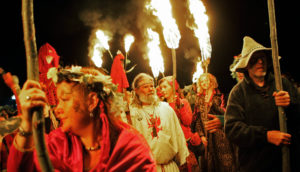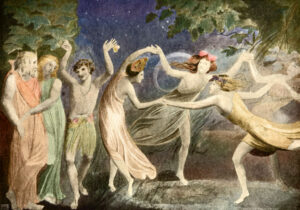“At every door in succession, a shout is raised, and the inhabitants, severally come forth, bestow there kindly greetings and donatives of money on the BURRYMAN who in this way collects, we believe, considerable sums of money to be eventually divided and spent at the Fair by the youth associated in this exploit.” — W.W.Fyffe
No one will ever know quite when it began. Nor even why. But for hundreds of years, on the second Friday in August, a man in a small town in the south-east of Scotland has been covered with thousands of prickly plants and paraded for a nine-hour walk through the streets. Being plied with whisky eases his ordeal.
Long intrigued, I travelled up to South Queensferry this year to see Burryman day myself. When I arrive at my hotel, the receptionist asks if I am the Burryman himself. Alas not. To be the Burryman you need to have been born in South Queensferry. And since 2012 the title has gone to Andrew Taylor, a 42-year-old who works for Edinburgh Council. Not only is Taylor a South Queensferry native, he was born in the Staghead Hotel, the starting point for the Burryman’s epic walk. He was “destined to be the Burryman”.
Various theories swirl around as to the origins of this eccentric folk tradition. One man tells me the Burryman was supposed to emerge from the sea, clutching the poles he now holds during his walk. And in the 19th century, according to Natalie Doig, who runs a history podcast called Weird in the Wade, both a man and a woman took part, known as the King and Queen. Alison, one of this year’s Burryman’s helpers, says that he is adorned with burrs because of… something to do with someone hiding from Oliver Cromwell and covering themselves in burrs.
You can see why he might need the whisky. Burrs don’t make comfortable clothes. And the night before the procession, thousands (approximately 11,000) of the spikey plants are collected for Burryman’s coat. They will cling viciously, with no need for glue. To protect his skin, he has to wear a tightly sewn undergarment, including a balaclava. A hot day is not Burryman’s friend. The garb means he can’t walk properly and has only small eye and mouth holes. But in South Queensferry, even though these burrs can cause irritation, injury and discomfort, they are emblems of good fortune.
And this is essentially the only thing we really know about the Burryman — he is supposed to bring good luck. It is one of a few similar rituals in local towns, all supposed to guarantee a good haul in the vital fishing trade. Aberdeen had a remarkably similar “Burreyman” also clad in prickles, but he was actually cast out of the town, along with the bad fishing luck. Unfortunately, because so much rested on the certainty of a good catch, he was often pursued and killed — something that might make the day harder to market as a quaint old British tradition.
“Hip hip hooray, it’s the Burryman’s day!” George rings a bell and off we go. Our prickly star steps out of the Staghead where he is met by a gaggle of locals, tourists and photographers. A flowery garland perched on his head, he looks a little agonised as waddles stiffly around with the aid of two helpers and two poles bearing flowers and the royal banner of Scotland.
And so, within minutes of his seven-mile tour starting he stops for a “nip” of whisky to drink through a straw. This is a sacred feature of the modern iteration: the Burryman takes a drink at around 30 stops on his journey — including every pub. If he is offered one, so the lore stipulates, he has to accept. As the day wears on, the number of houses visited falls and the number of pubs rises. Though some accounts stipulate that the Burryman should not speak for the day — difficult, admittedly, through his small mouth hole and given the effects of the whisky — Taylor chats amiably with everyone. One man sings a song about him: “The women think he’s sex on legs / But he stops for lunch in Greggs. And an old woman wearing a top hat reads him a poem she’s written, eyes glistening all the while.”
The responsibility of the role and the outfit weigh heavily on the Burryman — and poor Taylor. In previous years, according to W W Fyffe, it was common for Burrymen to faint “under the heat and fatigue of the dressing”. I worry that Taylor might suffer the same kind of fate. “I’m a wee bit sore,” he says around the half-way mark, “but I’m OK.” The worst part, he says, are the arms, which are always extended out to the side to accommodate the bulkiness of the garb. He approaches the honour of the role with great seriousness: “You sort of switch off from anybody around you. You’re in your own wee world for the whole day, it sometimes feels like.”
The outfit also terrifies small children. “He’s meant to be a good thing that comes round to take the evil spirits away,” says Alison. “But it’s a big guy that looks like a bush, walking about.” He does, indeed, look like someone who might haunt even an adult’s dreams and even appear as a Doctor Who monster. His message is just as ambiguous as his past. While he appears to be a scapegoat punishing himself in service of the town, he is also supposed to be benevolent and literally made of good luck. Is he kindly, or wicked? Should he stay or should he go? The locals seem averse to casting him as a villain. They don’t want to throw him out, they want to give him whisky and coins.
At 5.30pm, a bagpiper plays us down the home stretch. The Staghead is almost in sight. Someone gives Taylor a whisky milkshake. After nine gruelling hours, he arrives where he started to be cut out of his outfit and gives a grateful, sweaty speech to the assembled crowd — which I’m told is bigger than ever.
Ben Edge, an artist inspired by the Burryman, is here for the fifth year. “I’ve been quite interested in the idea of it being a kind of activism to come to these things,” he says, “because we’re not all in tune with the wheel of the year any more.” With the need to guarantee good fishing gone, the value of the Burryman lies more in the simple fact that it brings people together. “It would be probably really traumatic and upsetting for the town if the Burryman wasn’t to come out one year.”
That he wasn’t being pursued and killed must have helped maintain the tradition. Along with the doughty nature of the man at its heart. But Taylor admits that with 13 Burrymen outings under his belt, he is “on the decline”. And that it might be time to make way for someone younger. His predecessor, John Nichol, went for 12 years. And before him, Alan Reid did it for 25. But when I press him, Taylor won’t put a number on it. It’s a significant responsibility to be a “custodian of the Burryman”: it’s far bigger than just him. With fishing no longer the vital lifeline it once was, these other local customs have died out. Indomitably, though, South Queenferry’s Burryman endures. Though it doesn’t really know why, the town can’t help but cling to him like the burrs on his suit.
Disclaimer
Some of the posts we share are controversial and we do not necessarily agree with them in the whole extend. Sometimes we agree with the content or part of it but we do not agree with the narration or language. Nevertheless we find them somehow interesting, valuable and/or informative or we share them, because we strongly believe in freedom of speech, free press and journalism. We strongly encourage you to have a critical approach to all the content, do your own research and analysis to build your own opinion.
We would be glad to have your feedback.
Source: UnHerd Read the original article here: https://unherd.com/




